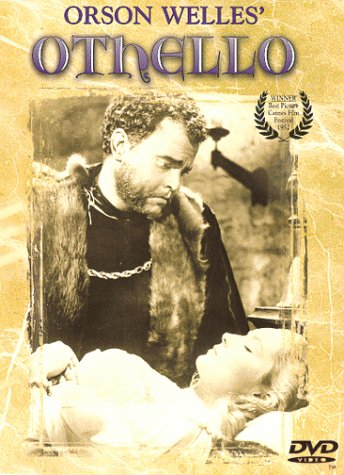Othello review by Jackass Tom
Shakespeare’s masterpiece becomes Welles’ masterpiece
The story of Othello brings back memories of 10th grade English. The memories are foggy at best. As I sit and watch the story rattling around in my head becomes a little more focused. When I first read Shakespeare’s work in high school it was accompanied by Welles’ work. At the time I didn’t get it. On one hand I was happy to be watching a movie in class; on the other hand it was black and white (anything pre-Star Wars back then didn’t exist). There were no dragons or battle scenes in Shakespeare’s work let alone in Welles’ movie so why should I care? Flashing forward to my twenties, I viewed Othello again with a little more sophistication and a little more respect for Orson Welles.
Othello and Desdemona had a ‘forbidden romance’. Othello was a moor, and Desdemona is a fair young maiden. Their hidden marriage is frowned upon by many, but most importantly frowned upon by Desdemona’s father. Iago, an officer of Othello, is a man of pure evil and he loathes young Othello. Not only is Iago evil, but he is also clever. Instead of using a sword to kill Othello, he uses his mind and his mouth to destroy him within. With Othello thinking he is a loyal officer, not to mention loyal friend, the mission all but too easy for the dastardly Iago.
Within Othello, Iago plants and tends to seeds of doubt. Othello is strong, but Iago sees a weakness: his jealousy. Iago makes claims of a love affair between Desdemona and Cassio. Othello would like to deny such allegations… but from his good pal Iago it has to be true. Slowly he begins to unravel as he sees what appear to be clues in favor of Iago’s claims. And whenever a new clue is ‘discovered’ Iago is right there to re-inforce Othello’s worst fears.
Othello is probably Welles’ most ambitious film since Cititzen Kane. He used dramatic camera angles, ingenious sets, and stark noir-ish shadows to accompany the powerful words of Shakespeare. Welles makes a point to open the movie, not with Shakespearean lines but with a fast-forward to a dark, yet glorious funeral sequence. Shots are choreographed to show off dark, sparsely clouded skies, and dark silhouettes of soldiers marching in a funeral of a fallen brother. Much like Kane no shot in Othello is a standard. You won’t find his work in the A-B-C’s of cinematography. His angles are shot either slightly low or slightly high. If one shadow is good, then fourteen shadows are better. Some shots are long, and some are extremely short and quick cutting. Welles appears to be at his best and most inspired in Othello.
Post-Kane it seems that Welles had troubles getting funding for nearly all of his films. Othello is a prime example as filming started in 1948 and wrapped up in 1951. Welles took on roles in other movies (Third Man is one such example) in order to keep Othello going. Through all of the money problems and time problems, it seems that Welles knew how to compensate inequity with sharp camera work. The only fault I see is during the murder of Cassio where shaky camera work used to create a sense of chaos is used in place of a true knife fight.
The only thing that shows in the latest re-mastering is a sound problem. Many voices are not synched well with the lips speaking. There are also moments where the lines being spoken are not clear or are being drown out by background noise. Another noticible sound item is the horns that were most likely added in the 1992 re-mastering. When you hear them it is obvious that they not the original ~1950 horn sound byte, but rather something generated in Windows Sound Recorder. All of this is unfortunate because had some of these technical problems not arose, this might be a film to rival Kane.
I am no Shakespearean scholar, so I am afraid I cannot give you a report on how correlated this movie version is to the actual text. From what I remember, like any movie, there were parts that were left out to save on time and of course the auteur director put his own twist a number of scenes and settings in order to create his dramatic interpretation. As far as I am concerned this is one of the most entertaining and eye-catching Shakespearean adaptations.
So much have I said about the director… I should give proper nods to the actors as well. The members of the cast are relatively unknown (to little American me), but they do a fantastic job. Suzanne Cloutier (as Desdemona) plays a strong and loyal. Even in her last moments she stands strong on her word that she has not betrayed her man. Micheal MacLiammoir is a sinister and truly evil Iago. He carries Othello around the film like a marionette, prancing him from corner to corner of the film by way of his vicious lies.
Despite its shortcomings, this is a work of art crafted brilliantly by a virtuoso. To watch it you probably have to be in the mood to see a Shakespearean drama. This is a must in the library of a true Welles fan (as I write this I realize that it is a missing piece on my own Welles shelf). If you rent it, make sure you get the 1992 re-master or sooner. I can’t imagine what this movie was like before it was touched up. In its current state it is slightly rough, but a true gem.









9 out of 10 Jackasses blog comments powered by Disqus
Search
Othello

IMDB Link: Othello
DVD Relase Date: 1999-08-31
DVD Aspect Ratio: 1.33:1
DVD Extras: Restoring the Movie Featurette